I was five years old when I first saw "Superman" on the big screen. The year was 1951 and back then several movie houses had special Kid's Saturday morning shows. I paid my Twenty-Cents and entered the La Brea Theater in Los Angeles. A typical Saturday morning program included two family rated motion pictures like "Bedtime for Bonzo" starring an actor named Ronald Reagan or "Abbott and Costello Meet the Invisible Man", five to seven cartoons, the latest episode of a cliff hanger Chapter Serial such as 1951's "Captain Video: Master of the Stratosphere". The last designed to keep us coming back the following Saturday and of course at Intermission a prize drawing.
One of the two feature films on this particular Saturday morning ran only 58 minutes and was "Superman and the Mole Men". While the Chapter Serial that day was from "Atom Man vs Superman". It may be funny that at 70 I remember this so clearly, but I was a born Science Fiction movie fan. Having as my first memory being in the backseat of my parents car, in my pajamas, at a drive-in movie showing George Pal's 1950 "Destination Moon". The Woody Woodpecker cartoon sequence always remained in my mind. However, I'm getting a head of myself and a little off track.
This article is an overview of the origins and first appearances of Superman, Superboy and Supergirl on both the motion picture and television screens.
THE ORIGIN OF SUPERMAN
In January 1933 High School student Jerry Siegel wrote a short story which his friend Joe Shuster illustrated. The story was published by Siegel in his own fan magazine. It's title was "The Reign of the Superman" and it was as far away from the "Man of Steel" as you could get. The "Superman" of this story uses an experimental drug and becomes psychic. He then uses these powers for self gain and evil amusement. Apparently Jerry Siegel used the pen name of Herbert S. Fine. As Fine is credited with writing the story for Siegel's third publication.

The two high school students started to develop a different version of the original character, but during this time broke up for a while and then came back together later in 1934.
For the next four years the two worked on this new version of "Superman" and attempted to get it published. Both felt their ages were the cause of many rejections by publishers who didn't take them seriously. Finally on April 18, 1938 with a cover date for the month of June "Superman" premiered in "Action Comics".
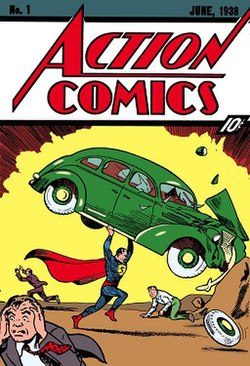
The above Ten Cent comic sold on eBay August 24, 2014, graded by the Certified Guaranty Company (CGC), as a 9.0 out of 10 for $3,207,852. Previously in 2010 a copy graded 8.0 sold for $1,000,000 and later another graded 8.5 for $1,500,000.
Speaking of money! The two creators of "Superman" Jerry Siegel and Joe Shuster thinking their character wouldn't be popular. Agreed to sell the rights to their creation for $130 1938 dollars to the company that would become Detective Comics (DC). This type of sale was not unusual as it was "Action Comics" policy to gain total control over of all the works they published. As of 2016 the amount paid to the two young men equates to $2,135.30. Multiple Lawsuits over time would be filed on the sale by Siegel and Shuster attempting to regain control of "Superman".
SUPERMAN THE FLEISCHER BROTHER'S ANIMATED SERIES
Known for creating the characters of Betty Boop and Popeye the Sailor were animators Max and Dave Fleischer. The brothers were the first to acquire the rights to bring Superman to the motion picture screen.


I first saw these cartoons in glorious black and white on an afternoon children's program on KTLA-TV originally called "The Pier Point 5 Show" but later "Popeye and Friends". It was easy for Los Angeles Channel 5 to get all the Fleischer Studio work for airing as it was owned by Paramount Pictures at the time.
Initially the Fleischers produced the pilot episode and eight other cartoons. The pilot was released September 26, 1941 and is known under two titles: "Superman", or "The Mad Scientist". A problem that Max and Dave Fleischer realized with the character was that in both the Comic Books and Radio Programs. "Superman" only "Leaped Tall Buildings" as I mentioned in my opening paragraph.
From an animators perspective that visual was hard to do. So they asked "Action Comics" for permission to change one aspect of the character and from this first cartoon forward. "Superman" started to fly. In 1945 the radio show that had been on the air since February 12, 1940 suddenly changed their character to fit what the Fleischer Brother's had started and the comic books were now reflecting.
Tuning in on September 5, 1945 listeners first heard a new opening:
Faster than a speeding bullet. More powerful than a locomotive. Able to leap tall buildings in a single bound.'
Look! Up in the sky!
It's a bird!
It's a plane!
It's Superman!
The "Mad Scientist" had a very short opening about how Superman came to Earth. The 10 minute 30 second cartoon then switched to the story of the title in which reporter Lois Lane, as would always happen, gets into trouble and needed to be saved
Below is an image from the first ever "Superman" cartoon.
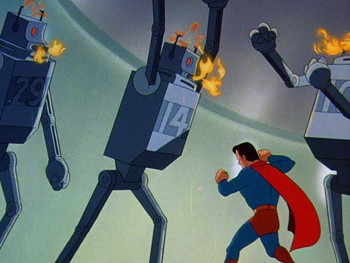
The quality of these first nine entries in the series is top notch and in some cases superior to the animation of Max's "enemy" Walt Disney at the same time.
The titles of the next eight cartoons that followed "The Mad Scientist" are in themselves very exciting:
The Mechanical Monsters released November 28, 1941
Billion Dollar Limited released January 18, 1942
The Arctic Giant released February 15, 1942
The Bulleteers released March 22, 1942
The Magnetic Telescope released April 19, 1942
Electric Earthquake released May 17, 1942
Volcano released July 12, 1942
Terror on the Midway released August 23, 1942
Below are scenes from "The Bulleteers" and note the detail on the newspaper for a 1942 cartoon. A sign of the Fleischer's quality and attention to that detail. Making the series very expensive compared to other studio's work.


The Fleischer Brothers got into financial troubles due to decisions Max had made over the years. The studio was eventually taken over by "Famous Studios" a branch of Paramount Pictures in 1942. Immediately the quality of the animation dropped as seen in the final eight entries of "Superman". "Famous Studios" was always looking for means to save money and time of production. The first entry under the new owners was pure World War 2 propaganda.
Japoteurs released September 18, 1942
Showdown released October 16, 1942
Eleventh Hour released November 20, 1942
Destruction, Inc released December 25, 1942
The Mummy Strikes released February 19, 1943
Jungle Drums released March 26, 1943
The Underground World released June 18, 1943
Secret Agent released July 30, 1943
Below are images from the "Japoteurs".


For those of my readers who are interested in animation and a more detailed explanation of the Fleischer Brothers "Superman" series. The following link will take you to my blog article on the feud between Max Fleischer and Walt Disney.
http://www.bewaretheblog.com/2015/04/the-great-walt-disney-max-fleischer.html
THE FIRST LIVE ACTION SUPERMAN
Five years after the Fleischer studio animations on January 5, 1948 audiences saw the first actor portray "Superman" on the motion picture screen. This was in a 15 Chapter Serial from Columbia Pictures simply called "SUPERMAN".
The posters for the serial showed the wonderful art work of the period even if they might have been more exciting than the real thing.
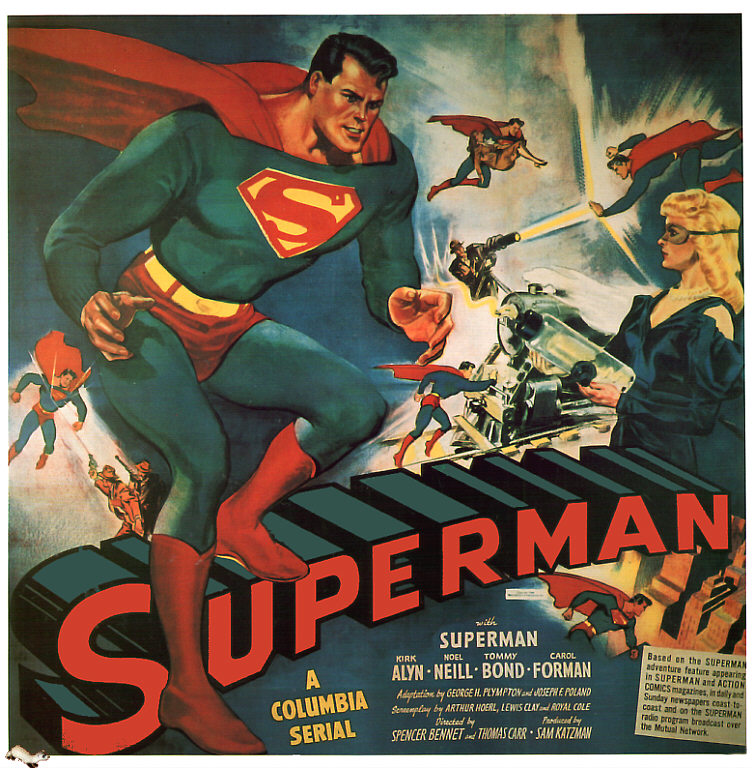
Below is the first actor to play the title character Kirk Alyn.

Kirk Alyn was born John Feggo, Jr. and started acting on Broadway. His first movie appearance was in 1930. A lot of Alyn's 65 motion pictures and television roles, even after "Superman", were small non-screen credited ones.
A little movie title confusion, but an interesting bit of trivia is that Kirk Alyn appeared in the first motion picture about the making of the Atomic Bomb "The Beginning or the End" in 1947 and ten years later appeared in Bert I. Gordon's 1957 Science Fiction film "The Beginning of the End".
In an article from the New York Times dated March 20, 1999, six days after the actor's death at 88. Alyn was quoted as saying about the day producer Sam Katzman asked him to play Superman:
I thought it was a publicity stunt. I didn't think you could ever put Superman on film. They brought the people from D.C. Comics over and they said, 'Hey, he looks just like Clark Kent.' They said take off your shirt, so I did and flexed my muscles. Then the guy said, 'Take off your pants' and I said, 'Wait a minute.' I was 37 when I played Superman. I picked up that girl and ran up that flight of stairs like it was nothing.
The first actress to play Lois Lane was Noel Darleen Neill. Noel Neill would portray Lois in both Columbia Serials and starting with the second season of the 1950's television series would again portray the character.
From left to right the first actors to portray on screen roles in Superman:
Pierre Watkin as Perry White
Kirk Alyn as Superman
Noel Neill as Lois Lane
Tommy Bond as Jimmy Olson

Before I mention the plot let me explain how Columbia Pictures worked at the time. The studio was under the "Rule" of it's founder Harry "KING" Cohn. Cohn gave producers a budget and expected high quality results with change back. The producer for both "Superman" serials was Sam Katzman.
Katzman learned his trade under Harry Cohn and produced some real cheap movies like "The Serpent of the Nile" starring red headed Rhonda Fleming in a Black Wig as Cleopatra and Raymond Burr as Mark Anthony. While on the flip side Science Fiction classics such as "It Came from Beneath the Sea" and "Earth vs the Flying Saucers". Another of "King" Cohn's producers in training was William Castle.
The biggest problem facing Sam Katzman was how to make Superman fly. The reverse of the Fleischer problem. In 1941 Republic Pictures released "Captain Marvel". The first comic book superhero to be seen on the motion picture screen. To show actor Tim Tyler in flight Republic used two major elements.
First part of making "Captain Marvel" fly was using a stunt man, in this case Dave Sharpe. Who standing on a very high point of the scene and set up for a proper camera angle, keeping his body as straight as possible jumped up into the air
The second part was a paper mache dummy of "Captain Marvel" weighing approximately 15 pounds and slightly over 7 feet in height. Tom Tyler was 6 feet 2 inches. The dummy was attached to a system of four pulley's which were then attached to two wires anchored at opposite sides of the scene. One end was slightly lower than the other. This simply caused the dummy to move across the set by it's own weight.
When the film of his jump was edited with the added footage of the dummy on the wire. The illusion of Tom Tyler flying was completed with insert a scene of the actor as shown below.
Sam Katzman wanted to do the same, but his budget did not permit this. So he animated "Superman" in flight. This was accomplished with Kirk Alyn looking like he was starting to fly at ground level and then the film switched to the animated character. When the animated character lands it was always behind something and then Alyn would easily walk into the scene from behind the prop.
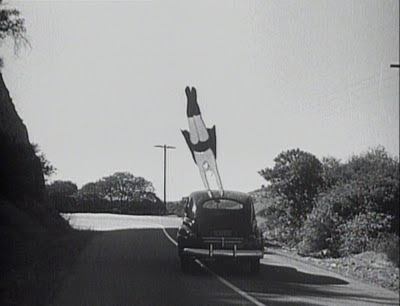

The first on screen villain was "The Spider Lady" played by actress Carol Forman. Forman was also in the 1949 serial "Federal Agents vs the Underworld" and the 1952 serial "Blackhawk: Fearless Champion of Freedom" both starring Kirk Alyn.
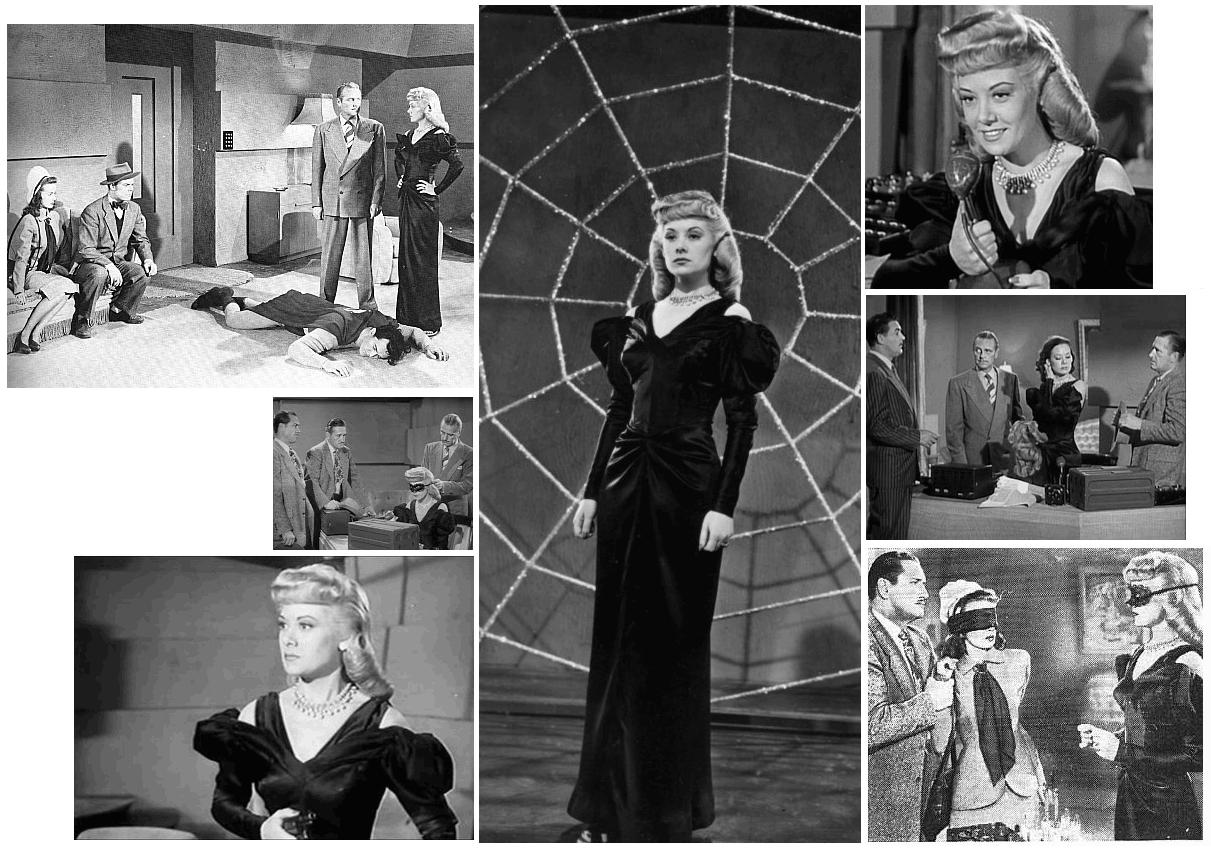
1948's "Superman" starts out in Chapter One with the destruction of Krypton and Kal-El coming to Earth.
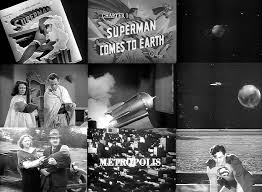
Another piece of trivia: Do you know Clark Kent's middle name?
In this first chapter after his foster parents pass away. Clark Joseph Kent decides to take the train to the large city of Metropolis to find work. On the train he meets Lois Lane and Jimmy Olson. While the train heads towards the city Clark sees a break in the train track and---Cliff Hanger Ending
The 15 Chapters of "Superman" tell the story of an inventor, Dr. Graham, who has discovered "reducer rays". His discovery can be focused at a great distance to cause an explosion more powerful than an Atomic Bomb. In 1948 and the decade before the serial was made there were a lot of strange type rays being discovered by scientists both sane and mad for science fiction stories. Probably the best film of this variety was Universal Studio's 1936 "The Invisible Ray" starring both Boris Karloff and Bela Lugosi.
The power of Dr. Graham's invention becomes known to the "Queen of the Underworld" the "Spider Lady" and the serial's plot is a battle of wits between her and the "Man of Steel". Early in the Chapters the discovery of the element "Kryptonite" occurs and it's effect on Clark Kent. Of course the "Spider Lady" learns of it and uses it at the climax of Chapter 15 to kill "Superman".

LET'S RETURN TO THAT SATURDAY MORNING I FIRST MET "THE MAN OF STEEL"
Kirk Alyn, Noel Niell, Pierre Watkin and Tommy Bond were back in the 15 Chapter serial "ATOM MAN VS SUPERMAN" released July 20, 1950. I do not remember which episode I saw, my memory isn't that good, but this Sam Katzman produced serial had the first on screen appearance of Lex Luthor.
The first actor to play Lex Luthor was Lyle Talbot.

Conversely the year before playing "Lex Luthor". Lyle Talbot was also the first actor to play "Commissioner Gordon" on screen in the 1949 Columbia serial "Batman and Robin".
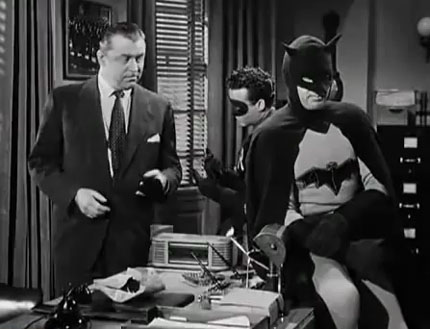
Talbot's acting career started in 1931 as he became a leading man for Warner Brothers Pictures. However, after he became an activist for the Screen Actors Guild Warner Brothers dropped him. No major studio would touch Lyle Talbot after that.
His career seemed to be at a dead end, but enter "King" Cohan who was always looking for good actors at a cheap price. Columbia Pictures picked Lyle Talbot up and the now character actor appeared in several Chapter Serials such as the two I've mentioned and other motion pictures. Then with the advent of television Lyle Talbot's career took a turn for the better as he became a regular on many shows. Among his work were as "The Brain" in five episodes of "Dick Tracy" and a forgotten TV program "Cowboy G-Men", For those fans of Edward "Ed" D. Wood, Jr., like myself, Lyle Talbot was seen in Wood's 1953 "Glenn or Glenda", 1954's "Jail Bait" and of course 1959's "Plan 9 From Outer Space" seen below.
.
The first chapter has Lex Luthor demanding the turning over of all the money in the banks of Metropolis, if he doesn't get the cash. Luthor threatens to destroy a bridge and even the entire city. Superman saves the bridge and arrests Lex.
One year later we see Luthor in solitary confinement offering to tell the government about an invention that combines television with radar. Meanwhile criminals are being seen using a special coin to teleport them a short distance to avoid police arrest.
Luther has one of the coins which he uses to take him out of his cell and to his hideout. There he informs the "Human Fly", "Killer Lawson", that he has actually perfected his machine and one more thing. Lex Luthor has a partner he calls "Atom Man". Lex than returns to his prison cell without anyone aware he left it.
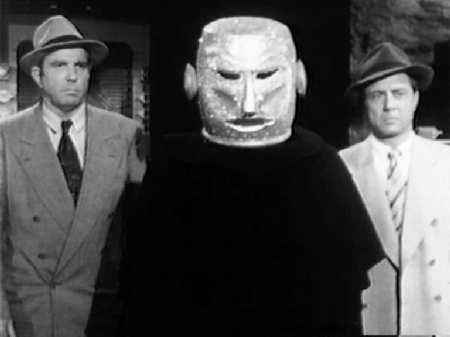
Lawson climbs a building to rob a jewelry store. He comes down.and uses the coin to teleport to a get away van, but is observed by Jimmy Olson. Jimmy gets into a small fight in the van and is knocked out. Lois Lane and the police start falling the van as is Superman. As the pursuers are getting closer the Van suddenly just stops and appears to explode. Continued next week.
Within the 15 Chapters Lex Luthor will create synthetic Kryptonite, use a Flying Saucer to destroy a plane with Lois and Clark on it and with his Radar/Television set watch all of Metropolis and Superman. Then at one point Atom Man aka: Lex Luthor sends Superman into "The Empty Doom" aka: "The Phantom Zone" causing him to be a ghost like figure that can not communicate with anyone. Can you say one really thrilling and excellent serial?
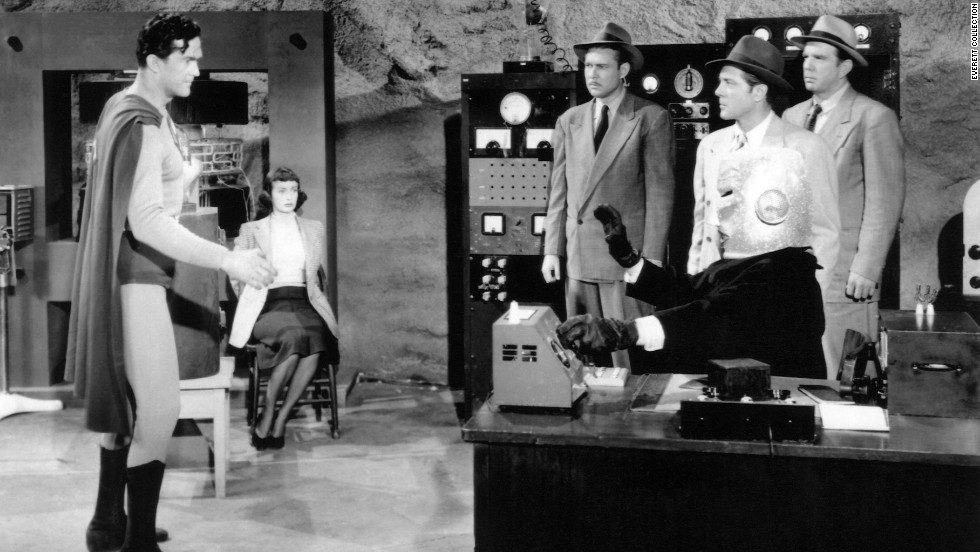


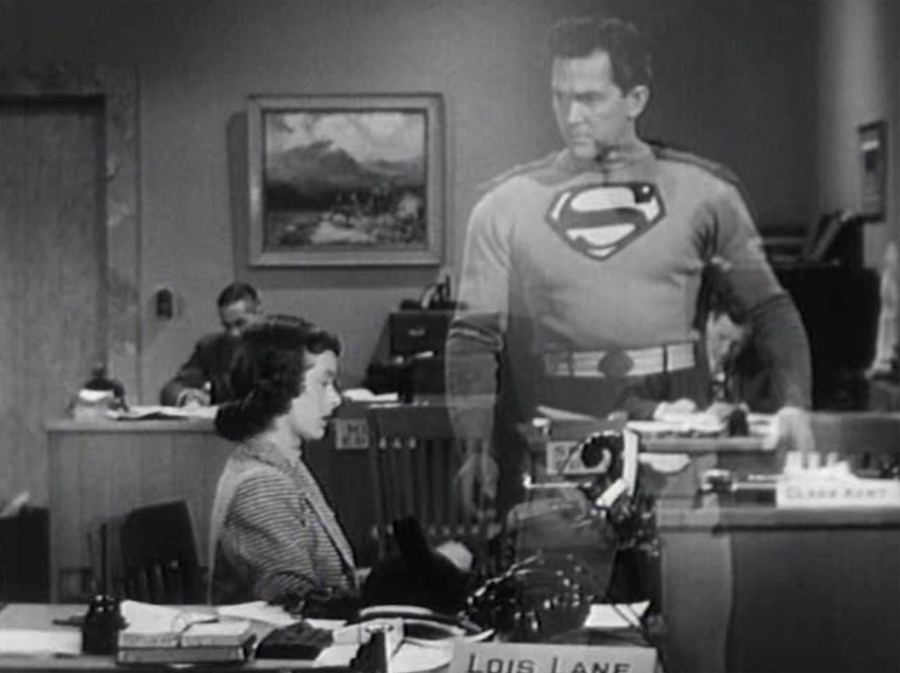
As I mentioned in my opening was a 58 minute long feature film
"SUPERMAN AND THE MOLE MEN"
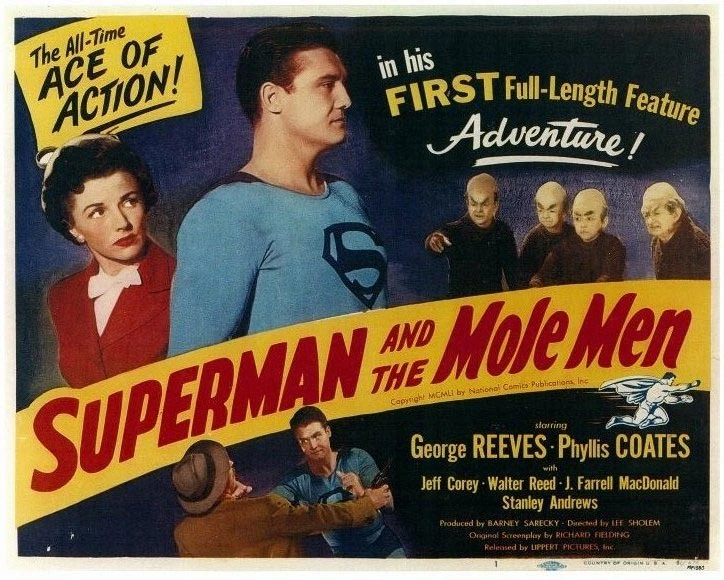
Notice on the above poster the color of George Reeves costume. As with Kirk Alyn's it was designed for Black and White photography. By today's standards a 58 minute motion picture doesn't seem to be a "Full-Length Feature", but the overall majority of "B" movies from the 1930's into the start of the 1950's, as this was, ran between 56 and 60 minutes in length. This was to cut the cost of production and to draw audiences into a theater with a double bill that was able to have maximum screenings in a day for profit.
The film was released by Robert L. Lippert Productions known for low budget motion pictures such as "Rocketship X-M", "The Lost Continent", "I Shot Jesse James" and "The Baron of Arizona", but also some interesting international releases such as "The Quatermas X-periment" aka: "The Creeping Unknown", "The Last Man on Earth" starring Vincent Price. Which is the first feature version of Richard Matheson's "I Am Legend" and the original 1958 "The Fly". Also starring Price and Al "David" Hedison.
Playing "Superman" was George Keefer Brewar who took the film name of George Reeves. Which helps counter the often thought relationship to Christopher Reeves the 1970's "Superman". A piece of trivia is that George Reeves played Brent Tarleton one of the two brothers who are Scarlet O'Hara's suitors at the start of the 1939 classic motion picture "Gone With the Wind".
In 1949 Reeves was working at Columbia studios and starred in the title role of Sam Katzman's 15 Chapter serial "The Adventures of Sir Galahad". Below is Reeves as Galahad.
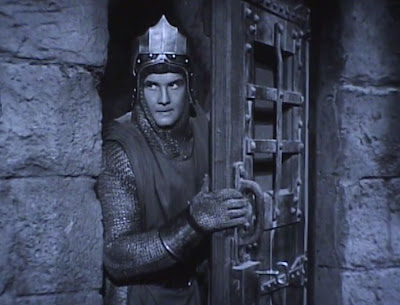
Playing Lois Lane was actress Phylliss Coates born Gypsie Ann Evarts Stell. Coates had been acting since 1947 in small roles. After leaving "The Adventures of Superman" Phylliss Coates had the title lead in one of the last of the Chapter serials Republic's 1955 "Panther Girl of the Kongo".
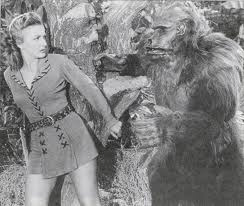
Another piece of trivia is found in the 1952 Science Fiction/Thriller "Invasion U.S.A.". This low budget picture was one of the first to deal with the Cold War sfear of the Soviet Union attacking and taking over the United States. In this movie you have Phyllis Coates playing Mrs, Mulfory and Noel Neill as the Second Airline Attendant in the only film with both Lois Lane actresses in it.
Clark Kent and Lois Lane are sent to the small mining community of Silsby where the World's deepest oil well is to be opened. What is unknown to everyone is that the well has reached the inner world of the Mole Men. At night they come out and initially frighten to death the night watchmen.
The townspeople are also becoming frightened of the Mole Men, because everything is suddenly glowing and it is believed to be radium. A popular radioactive element used in many Science Fiction stories like "The Invisible Ray".

In reality the glowing substance is nothing more than phosphorus rubbing off the hands of the Mole Men. One of the Mole Men is shot by the leader of a mob Luke Benson and needs medical assistance. Superman helps the doctor with an operation, because the doctor's nurse is too frightened to touch the tiny creature.
The townspeople led by Benson go to the hospital to take the injured Mole Men, but emerging from the Oil Well are others with a ray gun.

They aim the gun at Benson, but Superman steps between the laser ray and the mob leader. Afterwards he brings the injured Mole Man out and the others take him down the oil shaft and blow it up. Preventing anyone from ever entering their world.
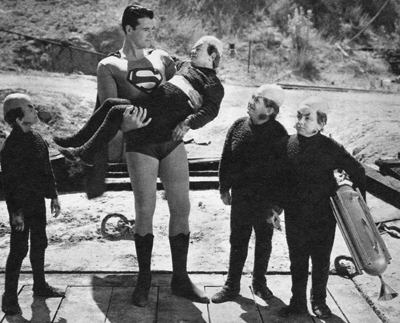
This feature would become a two part episode of "The Adventures of Superman" renamed "The Unknown People" and with all mention of "Mole Men" removed from the re-edit for television.
You had to be living in the United States at the start of the Cold War to understand the underlining theme of this story. It reflected American's fear of the Soviet Union and the idea that anyone you did not know could be one of "them", a Communist, or even your next door neighbor.
This film came out at the start of the "Black Listings" of members of the motion picture industry. Who were suspected of being, or who had actually been a member of the Communist Party. Problem here was the Russians were our allies during the Second World War and many patriotic Americans joined the party to show their support of our Communist friends.
Jeff Corey was called in front of the "House Committee on Un-American Activities" and refused to give names of those he knew in the film industry who were still, or had been Communists. His last film before he was "Black Listed" was "Superman and the Mole Man" in 1951. The next time Jeff Corey acted was providing a voice a voice in a "Mr. Magoo" cartoon in 1960. His first on screen role was in a 1961 episode of the television series "The Untouchables".
Should my reader want to get an idea of the McCarthy Era impact on the Motion Picture Industry. You may find my blog article about Screen Writer/Novelist Guy Endore and what happened to him as a result of actually being a member of the Communist Party interesting at:
http://www.bewaretheblog.com/2015/12/guy-endore-communism-in-motion-picture.html
THE ADVENTURES OF SUPERMAN
This television series was a spin off from "Superman and the Mole Men" and premiered on September 19, 1952 one month before my six birthday. The show starred both George Reeves and Phyllis Coates. My family and I would watch it on our big 17 inch black and white television screen.
Playing Jimmy Olson was Jack Larson.


The first on screen villain was "The Spider Lady" played by actress Carol Forman. Forman was also in the 1949 serial "Federal Agents vs the Underworld" and the 1952 serial "Blackhawk: Fearless Champion of Freedom" both starring Kirk Alyn.

1948's "Superman" starts out in Chapter One with the destruction of Krypton and Kal-El coming to Earth.
Another piece of trivia: Do you know Clark Kent's middle name?
In this first chapter after his foster parents pass away. Clark Joseph Kent decides to take the train to the large city of Metropolis to find work. On the train he meets Lois Lane and Jimmy Olson. While the train heads towards the city Clark sees a break in the train track and---Cliff Hanger Ending
The 15 Chapters of "Superman" tell the story of an inventor, Dr. Graham, who has discovered "reducer rays". His discovery can be focused at a great distance to cause an explosion more powerful than an Atomic Bomb. In 1948 and the decade before the serial was made there were a lot of strange type rays being discovered by scientists both sane and mad for science fiction stories. Probably the best film of this variety was Universal Studio's 1936 "The Invisible Ray" starring both Boris Karloff and Bela Lugosi.
The power of Dr. Graham's invention becomes known to the "Queen of the Underworld" the "Spider Lady" and the serial's plot is a battle of wits between her and the "Man of Steel". Early in the Chapters the discovery of the element "Kryptonite" occurs and it's effect on Clark Kent. Of course the "Spider Lady" learns of it and uses it at the climax of Chapter 15 to kill "Superman".

LET'S RETURN TO THAT SATURDAY MORNING I FIRST MET "THE MAN OF STEEL"
Kirk Alyn, Noel Niell, Pierre Watkin and Tommy Bond were back in the 15 Chapter serial "ATOM MAN VS SUPERMAN" released July 20, 1950. I do not remember which episode I saw, my memory isn't that good, but this Sam Katzman produced serial had the first on screen appearance of Lex Luthor.
The first actor to play Lex Luthor was Lyle Talbot.

Conversely the year before playing "Lex Luthor". Lyle Talbot was also the first actor to play "Commissioner Gordon" on screen in the 1949 Columbia serial "Batman and Robin".

Talbot's acting career started in 1931 as he became a leading man for Warner Brothers Pictures. However, after he became an activist for the Screen Actors Guild Warner Brothers dropped him. No major studio would touch Lyle Talbot after that.
His career seemed to be at a dead end, but enter "King" Cohan who was always looking for good actors at a cheap price. Columbia Pictures picked Lyle Talbot up and the now character actor appeared in several Chapter Serials such as the two I've mentioned and other motion pictures. Then with the advent of television Lyle Talbot's career took a turn for the better as he became a regular on many shows. Among his work were as "The Brain" in five episodes of "Dick Tracy" and a forgotten TV program "Cowboy G-Men", For those fans of Edward "Ed" D. Wood, Jr., like myself, Lyle Talbot was seen in Wood's 1953 "Glenn or Glenda", 1954's "Jail Bait" and of course 1959's "Plan 9 From Outer Space" seen below.
.

The first chapter has Lex Luthor demanding the turning over of all the money in the banks of Metropolis, if he doesn't get the cash. Luthor threatens to destroy a bridge and even the entire city. Superman saves the bridge and arrests Lex.
One year later we see Luthor in solitary confinement offering to tell the government about an invention that combines television with radar. Meanwhile criminals are being seen using a special coin to teleport them a short distance to avoid police arrest.
Luther has one of the coins which he uses to take him out of his cell and to his hideout. There he informs the "Human Fly", "Killer Lawson", that he has actually perfected his machine and one more thing. Lex Luthor has a partner he calls "Atom Man". Lex than returns to his prison cell without anyone aware he left it.

Lawson climbs a building to rob a jewelry store. He comes down.and uses the coin to teleport to a get away van, but is observed by Jimmy Olson. Jimmy gets into a small fight in the van and is knocked out. Lois Lane and the police start falling the van as is Superman. As the pursuers are getting closer the Van suddenly just stops and appears to explode. Continued next week.
Within the 15 Chapters Lex Luthor will create synthetic Kryptonite, use a Flying Saucer to destroy a plane with Lois and Clark on it and with his Radar/Television set watch all of Metropolis and Superman. Then at one point Atom Man aka: Lex Luthor sends Superman into "The Empty Doom" aka: "The Phantom Zone" causing him to be a ghost like figure that can not communicate with anyone. Can you say one really thrilling and excellent serial?



As I mentioned in my opening was a 58 minute long feature film
"SUPERMAN AND THE MOLE MEN"

Notice on the above poster the color of George Reeves costume. As with Kirk Alyn's it was designed for Black and White photography. By today's standards a 58 minute motion picture doesn't seem to be a "Full-Length Feature", but the overall majority of "B" movies from the 1930's into the start of the 1950's, as this was, ran between 56 and 60 minutes in length. This was to cut the cost of production and to draw audiences into a theater with a double bill that was able to have maximum screenings in a day for profit.
The film was released by Robert L. Lippert Productions known for low budget motion pictures such as "Rocketship X-M", "The Lost Continent", "I Shot Jesse James" and "The Baron of Arizona", but also some interesting international releases such as "The Quatermas X-periment" aka: "The Creeping Unknown", "The Last Man on Earth" starring Vincent Price. Which is the first feature version of Richard Matheson's "I Am Legend" and the original 1958 "The Fly". Also starring Price and Al "David" Hedison.
Playing "Superman" was George Keefer Brewar who took the film name of George Reeves. Which helps counter the often thought relationship to Christopher Reeves the 1970's "Superman". A piece of trivia is that George Reeves played Brent Tarleton one of the two brothers who are Scarlet O'Hara's suitors at the start of the 1939 classic motion picture "Gone With the Wind".
In 1949 Reeves was working at Columbia studios and starred in the title role of Sam Katzman's 15 Chapter serial "The Adventures of Sir Galahad". Below is Reeves as Galahad.

Playing Lois Lane was actress Phylliss Coates born Gypsie Ann Evarts Stell. Coates had been acting since 1947 in small roles. After leaving "The Adventures of Superman" Phylliss Coates had the title lead in one of the last of the Chapter serials Republic's 1955 "Panther Girl of the Kongo".

Another piece of trivia is found in the 1952 Science Fiction/Thriller "Invasion U.S.A.". This low budget picture was one of the first to deal with the Cold War sfear of the Soviet Union attacking and taking over the United States. In this movie you have Phyllis Coates playing Mrs, Mulfory and Noel Neill as the Second Airline Attendant in the only film with both Lois Lane actresses in it.
Clark Kent and Lois Lane are sent to the small mining community of Silsby where the World's deepest oil well is to be opened. What is unknown to everyone is that the well has reached the inner world of the Mole Men. At night they come out and initially frighten to death the night watchmen.
The townspeople are also becoming frightened of the Mole Men, because everything is suddenly glowing and it is believed to be radium. A popular radioactive element used in many Science Fiction stories like "The Invisible Ray".
In reality the glowing substance is nothing more than phosphorus rubbing off the hands of the Mole Men. One of the Mole Men is shot by the leader of a mob Luke Benson and needs medical assistance. Superman helps the doctor with an operation, because the doctor's nurse is too frightened to touch the tiny creature.
The townspeople led by Benson go to the hospital to take the injured Mole Men, but emerging from the Oil Well are others with a ray gun.

They aim the gun at Benson, but Superman steps between the laser ray and the mob leader. Afterwards he brings the injured Mole Man out and the others take him down the oil shaft and blow it up. Preventing anyone from ever entering their world.

This feature would become a two part episode of "The Adventures of Superman" renamed "The Unknown People" and with all mention of "Mole Men" removed from the re-edit for television.
You had to be living in the United States at the start of the Cold War to understand the underlining theme of this story. It reflected American's fear of the Soviet Union and the idea that anyone you did not know could be one of "them", a Communist, or even your next door neighbor.
This film came out at the start of the "Black Listings" of members of the motion picture industry. Who were suspected of being, or who had actually been a member of the Communist Party. Problem here was the Russians were our allies during the Second World War and many patriotic Americans joined the party to show their support of our Communist friends.
Jeff Corey was called in front of the "House Committee on Un-American Activities" and refused to give names of those he knew in the film industry who were still, or had been Communists. His last film before he was "Black Listed" was "Superman and the Mole Man" in 1951. The next time Jeff Corey acted was providing a voice a voice in a "Mr. Magoo" cartoon in 1960. His first on screen role was in a 1961 episode of the television series "The Untouchables".
Should my reader want to get an idea of the McCarthy Era impact on the Motion Picture Industry. You may find my blog article about Screen Writer/Novelist Guy Endore and what happened to him as a result of actually being a member of the Communist Party interesting at:
http://www.bewaretheblog.com/2015/12/guy-endore-communism-in-motion-picture.html
THE ADVENTURES OF SUPERMAN
This television series was a spin off from "Superman and the Mole Men" and premiered on September 19, 1952 one month before my six birthday. The show starred both George Reeves and Phyllis Coates. My family and I would watch it on our big 17 inch black and white television screen.
Playing Jimmy Olson was Jack Larson.
Larson had been in 12 previous motion pictures before he became Jimmy. In 1996 Jack Larson appeared as "Old Jimmy" in an episode of "Lois and Clark: The New Adventures of Superman". Ten years later he was "Bo the Bartender" in 2006's "Superman Returns".
Playing Perry White was veteran actor John Hamilton.

John Hamilton began acting in 1930 and among his appearances was playing the father of Flash Gordon in the 1949 serial "Flash Gordon Conquers the Universe", the District Attorney in John Huston's classic "The Maltese Falcon" and President Ulysses S. Grant in the 1954 motion picture "Sitting Bull". John Hamilton passed away six months after the last opposite of "The Adventures of Superman" with a lifetime carrier of motion picture and television appearances totally 347.
The fifth major character on the television series was Police Inspector Henderson portrayed by Robert Shayne.
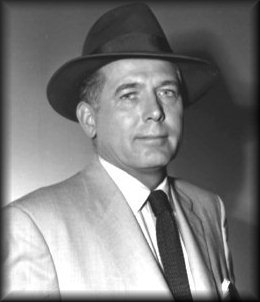
Shayne started acting in 1929. Among his pre-Superman credits were appearances in the Claude Rains, Betty Davis classic "Mrs. Skeffington", the Errol Flynn western "San Antonio" and the title role of a scientist who becomes "The Neanderthal Man".
From it's premier in 1952 into the start of 1954 when the show switched from black and white to color. The program was considered more an "Adult Drama" and the stories also reflected the start of the Cold War Era. Especially with the opening scene:that has George Reeves's "Superman" standing with outer space behind him and then ends with the American Flag waving.


As the audience originally heard during the sequence:
When the program turned to color filming the patriotic opening remained.

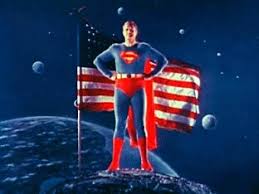
Like most television shows of the early 1950's the sponsor's name, in this case "Kellogg", is incorporated in the show. The initial first season was filmed in 1951 and went into a hiatus to find a sponsor. As a result Phyliss Coates found other work and could not continue as Lois Lane and Noel Neill joined the cast in the role she had created for the reminder of the series.


Note the very similar hairdo's of both Lois's and with similar dress viewers initially thought there wasn't a change in actresses. The debate still goes on as to which actress was the better Lois Lane.
Phyliss Coates appeared in 26 episodes of "The Adventures of Superman" initially from September 19, 1952 through August 10, 1953. Which included the edited "Superman and the Mole Man" as the now two part "The Unknown People".
While Noel Neill appeared in Seasons 2 through 6 for a total of 78 episodes. The final episode of the series "All That Glitters" premiered April 28, 1958.
While the series was being filmed a script for a proposed motion picture entitled "Superman and the Secret Planet" was written about a tyrant that wants to colonize the Earth. It was never made, but was to have had the original cast. Two interesting variations o this story have been made in there own way.
The first was an on line comic book adaptation of the script written by David Chantler. It was created by Randy Garrett. Garrett drew the characters to look like the actors of the 1950's television series.

Then the idea was taken a step further with a seven part movie of sorts. That can be found as if this writing on YouTube. The program stars actor David Hedison as Jor-El and then taking stills from the original color programs of "The Adventures of Superman". It adds George Reeves, Noel Neill , Jack Larson and Robert Shayne to the story.



Below "The Adventures of Superman" producer Frederic Whitney Ellsworth.

Any of my readers a fan of "Underdog"?
In 1958 with "The Adventures of Superman" coming to an end. Producer Whiney Ellsworth pitched a replacement parody that was not picked up, The title was "The Adventures of Superpup" set in an alternate Universe.
The cast of live action characters in costumes included "Bark Bent" the secret identify of "Superpup". Reporter "Pamela Poodle", who with "Bark" work for editor "Terry Bite" at the "Daily Bugle".
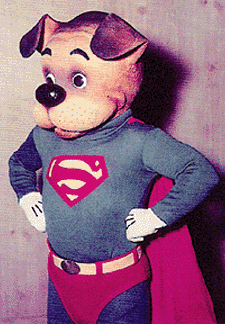

As of this writing my reader can find an episode of this purposed program on the Internet.
THE ORIGIN OF SUPERBOY
Return to 1938 the year "Superman" first appeared in "Action Comics". The month is now November and Jerry Siegel approached Detective Comics about his idea for "Superboy" and was turned down. The character was portrayed more as a prankster getting into a lot of trouble and DC thought that went against the image of the adult Kal-El. Two years later Siegel revised the character and was once more turned down. However, a short time after that second attempt. Two Detective Comic hero's were getting side kicks and we now had "Batman and Robin" and "Green Arrow and Speedy". The format was getting large public approval and the idea of a young Kal-El become a given to DC.
"Superboy" first appeared in Volume One, Issue 101 of "More Fun Comics" in 1944.
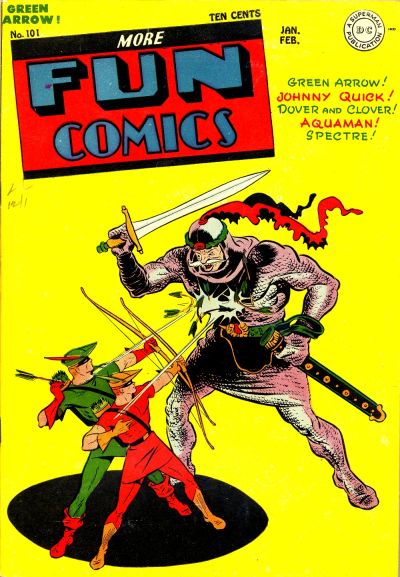
For the March-April 1949 comic book audience Volume One, Issue One of "Superboy" came out.

THE ADVENTURES OF SUPERBOY
Whitney Ellsworth was not put back by not finding a sponsor for "The Adventures of Superpup" and in 1961 the producer created a 29 minute, 25 second long pilot for a proposed television series "The Adventures of Superboy". Ellswoth then cast the first actors to play the Smallville residents Clark Kent and Lana Lang.
Playing Clark/Superboy was 17 year old Johnny Rockwell.

The young actor had have a career totaling 14 large and small screen credits. These iucluded appearing as two different characters on two programs of "The Many Loves of Dobie Gillis" starring Dwayne Hickman and Bob Denver, Along with walk-on's in the following features the Sophia Loren and Anthony Quinn movie "Heller in Pink Tights", the Doris Day and David Niven picture "Please Don't Eat the Daisy's" and the Jane Fonda and Anthony Perkins movie "Tall Story".
Portraying the first Lana Lang was 18 year old Bunny Henning.

The actress made a total of five appearances including this one. Four on the small screen and one as a Gnome Maiden in Walt Disney's "The Gnome-Mobile".
The other proposed regular was to have been actress Monty Margetts as Martha Kent. Margetts appeared in many television programs for the 20 year period between 1956 and 1976.
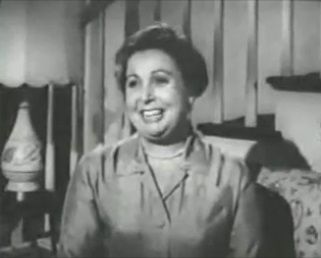
Besides the pilot named "Rajah's Ransom" Ellsworth had 12 additional scripts prepared for production, but he could not find a sponsor. The costs of making the show was deemed too expensive at the time.
Looking at what was on television in 1961. It is possible to see why this show was declined. Most of the programs used existing set pieces for a location which kept the cost down. They included "Gunsmoke" that used existing Western sets dating back to the silent era, As did "Have Gun Will Travel", "Laramie" and even "Bonanza". "Leave It to Beaver", "My Three Sons", "The Donna Reed Show" and "The Dick Van Dyke Show" all used basically a family's house set for the majority of the action and streets sets from decades before.
Here are some scenes from "The Adventures of Superboy" pilot which as of this writing is available on the Internet.

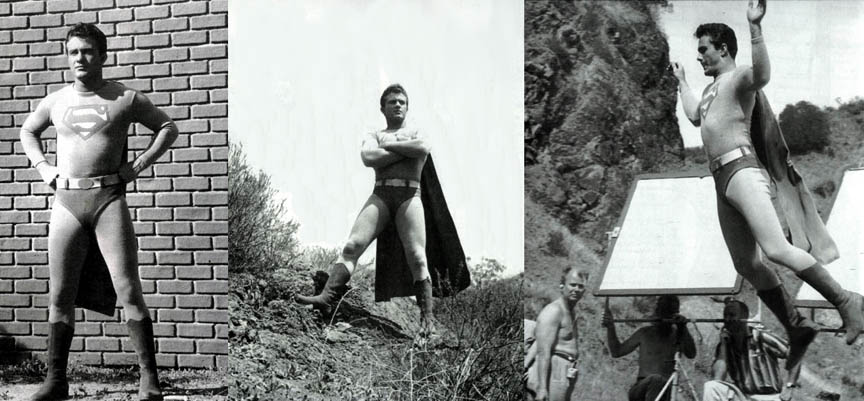
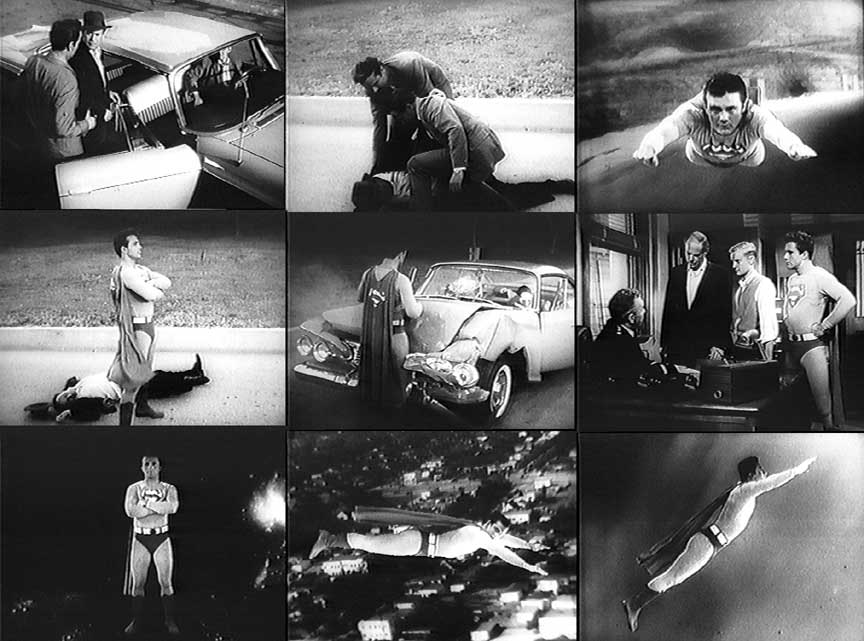
In 1966 "Superboy" also appeared on CBS in a 34 episode animated series from Flimation also called "The Adventures of Superboy". Each cartoon was six minutes in length and the three seasons ran through 1969, but never as its own show. These cartoons were integrated into other programs.



"Superboy" finely made it to live action television in 1988.
During the First Season starting in October 1988 the role of Clark Kent/Superboy was played by John Haymes Newton. He was replaced for the second after two things occurred. First his demand for more money and a major DUI arrest.

Season 2 through 4 Clark Kent/Superboy was played by Gerard Christopher

Changes also occurred to villain Lex Luthor. In the first Season he was played by Scott Wells.

During the Second Season he was replaced by Sherman Howard. A two part episode explained Lex had plastic surgery to change his appearance.
.jpg/revision/latest?cb=20140830233311)
Another piece of Trivia for this program was the second James Bond actor George Lazenby portrayed Jor-El.
Lazenby as James Bond in 1969's "On His Majesty's Secret Service". The one Bond film without Sean Connery during his original run with the character over money and Connery becoming bored with the character.

Lazenbv as Jor-El in his two episodes of the First Season of television's "Superboy",
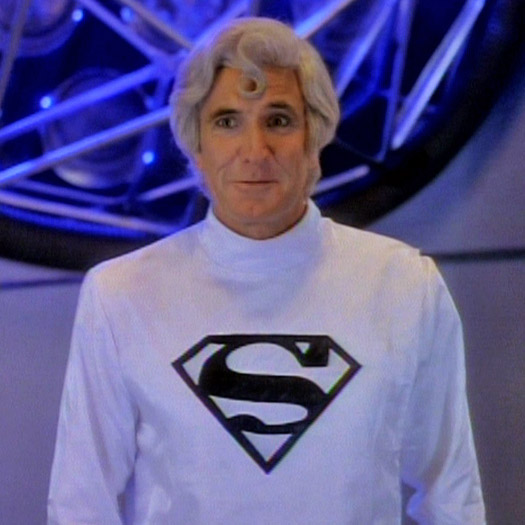
The series was extremely popular during it's Fourth and final Season, but counter court cases over control resulted in the program being dropped.
AND THEN THERE WAS SUPERGIRL
Detective Comics assigned writer Otto Binder to create a story revolving around a female version of "Superboy". Binder had written the comic series "Superman's Pal Jimmy Olson", wrote "Krypto the Superdog" and created "The Phantom Zone". Binder worked with illustrator Al Pastino.
The original illustrations of the character of "Supergirl" were by Pastino. Al Pastino also was the original illustrator for the characters of "Braniac" and the teenage "Legion of Super Heroes".
Superman's cousin Kara Zor-El wasn't the first "Supergirl", or for that matter "Super Women".
"Action Comics" Number 60 from May 1943 contained a story about Lois Lane dreaming she was "Superwomen" below. While "Action Comics" Number 156 from May 1951 had Lois also becoming "Superwomen" because of something Lex Luthor did to her.
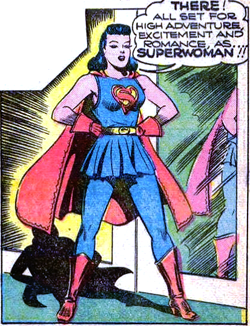
In "Superboy" Number 5 for November-December 1949 there was the story "Superboy Meets Supergirl". In which the athletic Queen Lucy, of the Latin American Country of Borgonia, while visiting Smallville wears a costume and with Superboy's help is thought to be a Supergirl.
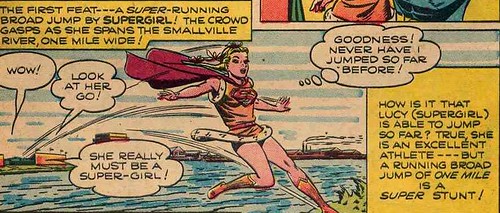
On the comic side of things. How about Superboy being turned into a girl? This happened in "Superboy" Number 78 released December 1959.
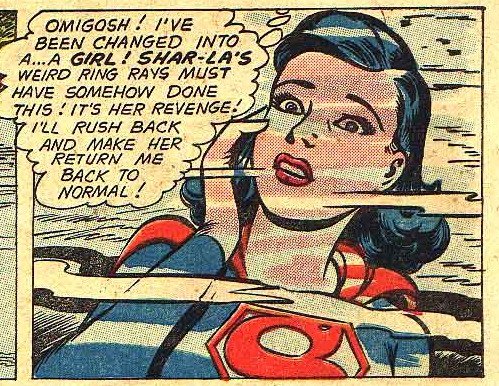
Then there was "Superman" Number 123 for August 1958 that has Jimmy Olson using a magic token to wish for a "Supergirl". His wish comes true and tragedy occurs when she protects Superman from a Kryptonite meteor and Jimmy wishes the dying Supergirl out of existence.

All of which brings my reader to "Action Comics" Number 252 for May 1959 which introduced Kal-El's cousin Kara Zor-El. Kara is sent to Earth by her parents from Argo City, a portion of Krypton that somehow survived it's destruction, but now faces it own from a meteor shower. In this story Kara takes the Earth name of Linda Lee, poses as an orphan and makes Midvale Orphanage her home.
THE SUPERGIRL MOTION PICTURE
On July 19, 1984 a British produced motion picture "Supergirl" premiered in England at a running time of 135 minutes. When it premiered on November 24, 1984 in the United States the running time had been reduced to 105 minutes. Not a very good sign.
Then it was re-edited for U.S. television to a running became 124 minutes. However, of further interest there is another so called theatrical U.S. running time of 92 minutes. Again not a good sign for a feature film that was supposed to start a franchise.
The movie starred newcomer Helen Slater. Who prior to this picture had only one other appearance in a 1982 ABC television "After School Special" called "Amy and the Angel". She played Amy. In "Supergirl" Helen Slater's character was Kara Zor-El, Supergirl and her secret identity of Linda Lee right out of the comic books. However, that was all that came from that source.
The feature's Executive Producer was Ilya Salkind who along with his father were the men behind the first three Christopher Reeve movies "Superman", "Superman II" and "Superman III". To both of them and other investors on paper "Supergirl" should have worked. Additionally the motion picture had an all star international cast.
Playing Kara's parents were British Actor Simon Ward as Zor-El and American Actress Mia Farrow as her mother Alura In-ze.

British Actor Peter O'Toole played Zaltar a rebellious, but a clear thinking scientist.
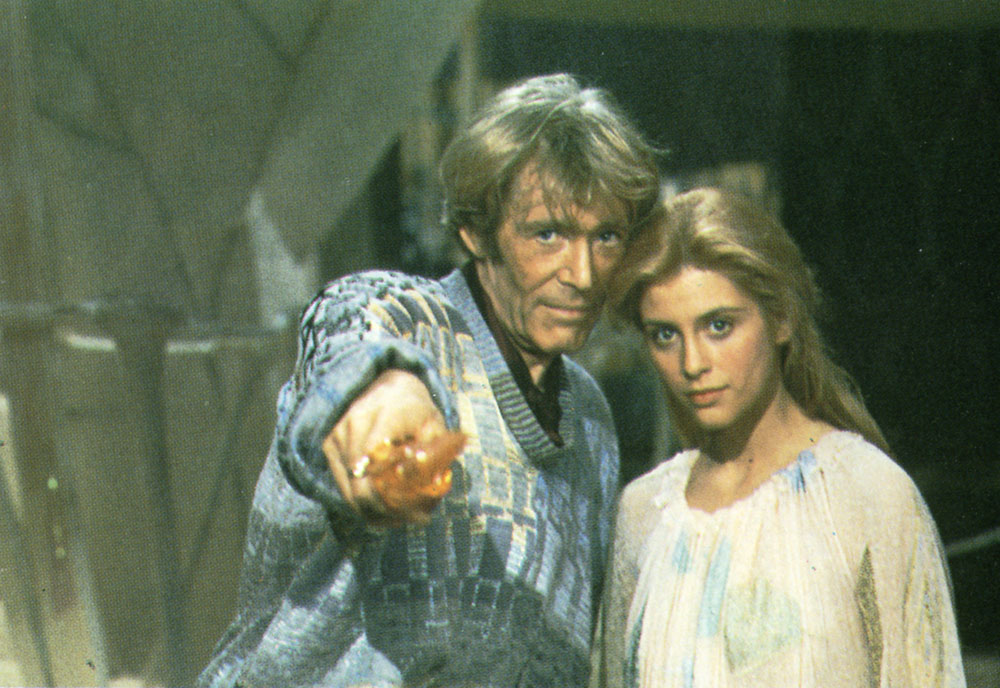
The villain was an over the top, big problem, performance by Faye Dunaway as a would be witch named Selena.
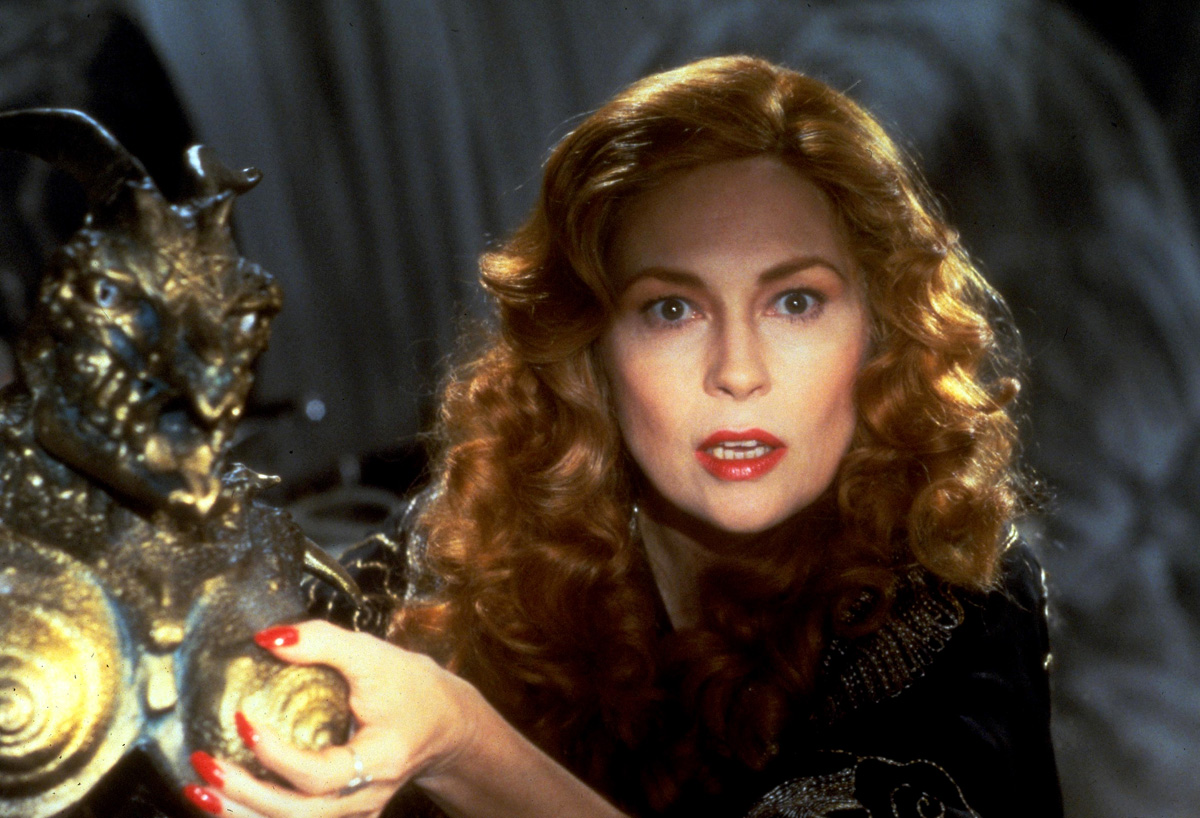
Playing Selena's comic assistant was Brenda Vacarro.

Originally the producers thought of having Helen Slater look more like the comic book character as this test shot shows.

Another original plan was to have Christopher Reeve appear in a cameo, but that was dropped. The non-appearance of Superman is explained as Selena listens to the radio and finds out he is on a peace mission in a distant galaxy.
Zaltar steals the "Omegahedron" which powers Argo City. Kara starts to fool around with it and ends sending it into deep space and eventually to Earth where Selena discovers it.
Kara decides to follow and retrieve the "Omegahedron", but her parents don't want her to leave Argo City. She convinces them she must and upon her arrival on Earth discovers her super powers. Kara identifies herself as Clark Kent's cousin. Which seems to imply she knows of Superman's secret identity. Seeing that Kal-El doesn't know Argo City survived according to the previous films. Perhaps as the script was completely rewritten at least once and Reeves bowed out of the movie. Somebody forgot to fix this plot line.
Most of the movie has Kara/Supergirl attempting to get the power source from Selena and her bungling assistant Bianca. The audience also has to listen to terrible almost Abbott and Costello imitation dialogue between Dunaway and Vacarro. One of the better scenes has Selena sending Supergirl into the "Eternal Void" aka: "Phantom Zone". Without her powers Kara finds Zaltar who has been punished and sent their for stealing Argo City's power source. He helps Kara escape by sacrificing his own life.
Then there is Ethan, played by Canadian actor Hart Bocher. He is the groundskeeper for a girls school the Kara is attending with Lucy Lane. Lucy Lane is the younger sister that she shares a bedroom that has a picture of Superman hanging on a wall.. Ethan becomes the love interest of both Slater and Dunaway.
Playing Perry White was veteran actor John Hamilton.

John Hamilton began acting in 1930 and among his appearances was playing the father of Flash Gordon in the 1949 serial "Flash Gordon Conquers the Universe", the District Attorney in John Huston's classic "The Maltese Falcon" and President Ulysses S. Grant in the 1954 motion picture "Sitting Bull". John Hamilton passed away six months after the last opposite of "The Adventures of Superman" with a lifetime carrier of motion picture and television appearances totally 347.
The fifth major character on the television series was Police Inspector Henderson portrayed by Robert Shayne.

Shayne started acting in 1929. Among his pre-Superman credits were appearances in the Claude Rains, Betty Davis classic "Mrs. Skeffington", the Errol Flynn western "San Antonio" and the title role of a scientist who becomes "The Neanderthal Man".
From it's premier in 1952 into the start of 1954 when the show switched from black and white to color. The program was considered more an "Adult Drama" and the stories also reflected the start of the Cold War Era. Especially with the opening scene:that has George Reeves's "Superman" standing with outer space behind him and then ends with the American Flag waving.

As the audience originally heard during the sequence:
Kellogg, 'The Greatest Name In Cereals', presents the Adventures of Superman!
Faster than a speeding bullet! More powerful than a locomotive! Able to leap tall buildings in a single bound!
("Look! Up in the sky!" "It's a bird!" "It's a plane!" "It's Superman!")
Yes, it's Superman... strange visitor from another planet, who came to Earth with powers and abilities far beyond those of mortal men! Superman... who can change the course of mighty rivers, bend steel in his bare hands, and who, disguised as Clark Kent, mild-mannered reporter for a great metropolitan newspaper, fights a never-ending battle for truth, justice, and the American way!
And now, another exciting episode in the Adventures of Superman!
When the program turned to color filming the patriotic opening remained.

Like most television shows of the early 1950's the sponsor's name, in this case "Kellogg", is incorporated in the show. The initial first season was filmed in 1951 and went into a hiatus to find a sponsor. As a result Phyliss Coates found other work and could not continue as Lois Lane and Noel Neill joined the cast in the role she had created for the reminder of the series.


Note the very similar hairdo's of both Lois's and with similar dress viewers initially thought there wasn't a change in actresses. The debate still goes on as to which actress was the better Lois Lane.
Phyliss Coates appeared in 26 episodes of "The Adventures of Superman" initially from September 19, 1952 through August 10, 1953. Which included the edited "Superman and the Mole Man" as the now two part "The Unknown People".
While Noel Neill appeared in Seasons 2 through 6 for a total of 78 episodes. The final episode of the series "All That Glitters" premiered April 28, 1958.
While the series was being filmed a script for a proposed motion picture entitled "Superman and the Secret Planet" was written about a tyrant that wants to colonize the Earth. It was never made, but was to have had the original cast. Two interesting variations o this story have been made in there own way.
The first was an on line comic book adaptation of the script written by David Chantler. It was created by Randy Garrett. Garrett drew the characters to look like the actors of the 1950's television series.

Then the idea was taken a step further with a seven part movie of sorts. That can be found as if this writing on YouTube. The program stars actor David Hedison as Jor-El and then taking stills from the original color programs of "The Adventures of Superman". It adds George Reeves, Noel Neill , Jack Larson and Robert Shayne to the story.



Below "The Adventures of Superman" producer Frederic Whitney Ellsworth.

Any of my readers a fan of "Underdog"?
In 1958 with "The Adventures of Superman" coming to an end. Producer Whiney Ellsworth pitched a replacement parody that was not picked up, The title was "The Adventures of Superpup" set in an alternate Universe.
The cast of live action characters in costumes included "Bark Bent" the secret identify of "Superpup". Reporter "Pamela Poodle", who with "Bark" work for editor "Terry Bite" at the "Daily Bugle".


As of this writing my reader can find an episode of this purposed program on the Internet.
THE ORIGIN OF SUPERBOY
Return to 1938 the year "Superman" first appeared in "Action Comics". The month is now November and Jerry Siegel approached Detective Comics about his idea for "Superboy" and was turned down. The character was portrayed more as a prankster getting into a lot of trouble and DC thought that went against the image of the adult Kal-El. Two years later Siegel revised the character and was once more turned down. However, a short time after that second attempt. Two Detective Comic hero's were getting side kicks and we now had "Batman and Robin" and "Green Arrow and Speedy". The format was getting large public approval and the idea of a young Kal-El become a given to DC.
"Superboy" first appeared in Volume One, Issue 101 of "More Fun Comics" in 1944.

For the March-April 1949 comic book audience Volume One, Issue One of "Superboy" came out.

THE ADVENTURES OF SUPERBOY
Whitney Ellsworth was not put back by not finding a sponsor for "The Adventures of Superpup" and in 1961 the producer created a 29 minute, 25 second long pilot for a proposed television series "The Adventures of Superboy". Ellswoth then cast the first actors to play the Smallville residents Clark Kent and Lana Lang.
Playing Clark/Superboy was 17 year old Johnny Rockwell.

The young actor had have a career totaling 14 large and small screen credits. These iucluded appearing as two different characters on two programs of "The Many Loves of Dobie Gillis" starring Dwayne Hickman and Bob Denver, Along with walk-on's in the following features the Sophia Loren and Anthony Quinn movie "Heller in Pink Tights", the Doris Day and David Niven picture "Please Don't Eat the Daisy's" and the Jane Fonda and Anthony Perkins movie "Tall Story".
Portraying the first Lana Lang was 18 year old Bunny Henning.

The actress made a total of five appearances including this one. Four on the small screen and one as a Gnome Maiden in Walt Disney's "The Gnome-Mobile".
The other proposed regular was to have been actress Monty Margetts as Martha Kent. Margetts appeared in many television programs for the 20 year period between 1956 and 1976.

Besides the pilot named "Rajah's Ransom" Ellsworth had 12 additional scripts prepared for production, but he could not find a sponsor. The costs of making the show was deemed too expensive at the time.
Looking at what was on television in 1961. It is possible to see why this show was declined. Most of the programs used existing set pieces for a location which kept the cost down. They included "Gunsmoke" that used existing Western sets dating back to the silent era, As did "Have Gun Will Travel", "Laramie" and even "Bonanza". "Leave It to Beaver", "My Three Sons", "The Donna Reed Show" and "The Dick Van Dyke Show" all used basically a family's house set for the majority of the action and streets sets from decades before.
Here are some scenes from "The Adventures of Superboy" pilot which as of this writing is available on the Internet.



In 1966 "Superboy" also appeared on CBS in a 34 episode animated series from Flimation also called "The Adventures of Superboy". Each cartoon was six minutes in length and the three seasons ran through 1969, but never as its own show. These cartoons were integrated into other programs.

"Superboy" finely made it to live action television in 1988.
During the First Season starting in October 1988 the role of Clark Kent/Superboy was played by John Haymes Newton. He was replaced for the second after two things occurred. First his demand for more money and a major DUI arrest.
Season 2 through 4 Clark Kent/Superboy was played by Gerard Christopher

Changes also occurred to villain Lex Luthor. In the first Season he was played by Scott Wells.

During the Second Season he was replaced by Sherman Howard. A two part episode explained Lex had plastic surgery to change his appearance.
.jpg/revision/latest?cb=20140830233311)
Another piece of Trivia for this program was the second James Bond actor George Lazenby portrayed Jor-El.
Lazenby as James Bond in 1969's "On His Majesty's Secret Service". The one Bond film without Sean Connery during his original run with the character over money and Connery becoming bored with the character.

Lazenbv as Jor-El in his two episodes of the First Season of television's "Superboy",

The series was extremely popular during it's Fourth and final Season, but counter court cases over control resulted in the program being dropped.
AND THEN THERE WAS SUPERGIRL
Detective Comics assigned writer Otto Binder to create a story revolving around a female version of "Superboy". Binder had written the comic series "Superman's Pal Jimmy Olson", wrote "Krypto the Superdog" and created "The Phantom Zone". Binder worked with illustrator Al Pastino.
The original illustrations of the character of "Supergirl" were by Pastino. Al Pastino also was the original illustrator for the characters of "Braniac" and the teenage "Legion of Super Heroes".
Superman's cousin Kara Zor-El wasn't the first "Supergirl", or for that matter "Super Women".
"Action Comics" Number 60 from May 1943 contained a story about Lois Lane dreaming she was "Superwomen" below. While "Action Comics" Number 156 from May 1951 had Lois also becoming "Superwomen" because of something Lex Luthor did to her.
In "Superboy" Number 5 for November-December 1949 there was the story "Superboy Meets Supergirl". In which the athletic Queen Lucy, of the Latin American Country of Borgonia, while visiting Smallville wears a costume and with Superboy's help is thought to be a Supergirl.

On the comic side of things. How about Superboy being turned into a girl? This happened in "Superboy" Number 78 released December 1959.

Then there was "Superman" Number 123 for August 1958 that has Jimmy Olson using a magic token to wish for a "Supergirl". His wish comes true and tragedy occurs when she protects Superman from a Kryptonite meteor and Jimmy wishes the dying Supergirl out of existence.

All of which brings my reader to "Action Comics" Number 252 for May 1959 which introduced Kal-El's cousin Kara Zor-El. Kara is sent to Earth by her parents from Argo City, a portion of Krypton that somehow survived it's destruction, but now faces it own from a meteor shower. In this story Kara takes the Earth name of Linda Lee, poses as an orphan and makes Midvale Orphanage her home.
THE SUPERGIRL MOTION PICTURE
On July 19, 1984 a British produced motion picture "Supergirl" premiered in England at a running time of 135 minutes. When it premiered on November 24, 1984 in the United States the running time had been reduced to 105 minutes. Not a very good sign.
Then it was re-edited for U.S. television to a running became 124 minutes. However, of further interest there is another so called theatrical U.S. running time of 92 minutes. Again not a good sign for a feature film that was supposed to start a franchise.
The movie starred newcomer Helen Slater. Who prior to this picture had only one other appearance in a 1982 ABC television "After School Special" called "Amy and the Angel". She played Amy. In "Supergirl" Helen Slater's character was Kara Zor-El, Supergirl and her secret identity of Linda Lee right out of the comic books. However, that was all that came from that source.
The feature's Executive Producer was Ilya Salkind who along with his father were the men behind the first three Christopher Reeve movies "Superman", "Superman II" and "Superman III". To both of them and other investors on paper "Supergirl" should have worked. Additionally the motion picture had an all star international cast.
Playing Kara's parents were British Actor Simon Ward as Zor-El and American Actress Mia Farrow as her mother Alura In-ze.

British Actor Peter O'Toole played Zaltar a rebellious, but a clear thinking scientist.

The villain was an over the top, big problem, performance by Faye Dunaway as a would be witch named Selena.

Playing Selena's comic assistant was Brenda Vacarro.

Originally the producers thought of having Helen Slater look more like the comic book character as this test shot shows.

Another original plan was to have Christopher Reeve appear in a cameo, but that was dropped. The non-appearance of Superman is explained as Selena listens to the radio and finds out he is on a peace mission in a distant galaxy.
Zaltar steals the "Omegahedron" which powers Argo City. Kara starts to fool around with it and ends sending it into deep space and eventually to Earth where Selena discovers it.
Kara decides to follow and retrieve the "Omegahedron", but her parents don't want her to leave Argo City. She convinces them she must and upon her arrival on Earth discovers her super powers. Kara identifies herself as Clark Kent's cousin. Which seems to imply she knows of Superman's secret identity. Seeing that Kal-El doesn't know Argo City survived according to the previous films. Perhaps as the script was completely rewritten at least once and Reeves bowed out of the movie. Somebody forgot to fix this plot line.
Most of the movie has Kara/Supergirl attempting to get the power source from Selena and her bungling assistant Bianca. The audience also has to listen to terrible almost Abbott and Costello imitation dialogue between Dunaway and Vacarro. One of the better scenes has Selena sending Supergirl into the "Eternal Void" aka: "Phantom Zone". Without her powers Kara finds Zaltar who has been punished and sent their for stealing Argo City's power source. He helps Kara escape by sacrificing his own life.
Then there is Ethan, played by Canadian actor Hart Bocher. He is the groundskeeper for a girls school the Kara is attending with Lucy Lane. Lucy Lane is the younger sister that she shares a bedroom that has a picture of Superman hanging on a wall.. Ethan becomes the love interest of both Slater and Dunaway.
After Selena is defeated and Ethan freed from her love potion spell. Ethan tells "Linda Lee" that he knows she is "Supergirl" and that he loves her. However, he realizes she must return the "Omegahedron" to Argo City. The movie ends with "Supergirl" placing the power source back and Argo City lighting up.
Not a very engaging story line and compared to the first two of the Christopher Reeve films boring.
On May 2, 1998 the first television appearance of "Supergirl" took place in "Superman: The Animated Series". The episode was called "Little Girl Lost". In this story there are also changes to the original origin of Kara. In deep space Superman discovers the planet Argo. The planet was affected by the destruction of Krypton and became a frigid world. For protection of her family a scientist named Kala In-Ze placed them in suspended animation. All the chambers have been destroyed except one containing a teenage girl Kara In-Ze.
The story cuts to three years later the girl now on Earth has become "Supergirl" and is told she must watch out nobody discovers her superpowers and stay out of trouble.
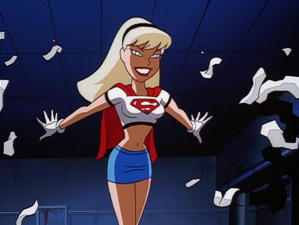
This was a two part cartoon and during the second part Supergirl helps Superman defeat Darkseid and the Furies.
From this point forward Supergirl started to guest appear on different DC animated series. She teamed up with Batgirl in one series and became a member of the new Justice League in another.
A completely different take on Kara and Supergirl was her first live appearance as part of the television show "Smallville". Which itself was a completely updated feel to the life of the young Clark Kent/Superboy. During the final episode of Season Six on May 17, 2007. Kara is freed after 18 years from suspended animation. Kara/Supergirl was played by Laura Vandervoot.

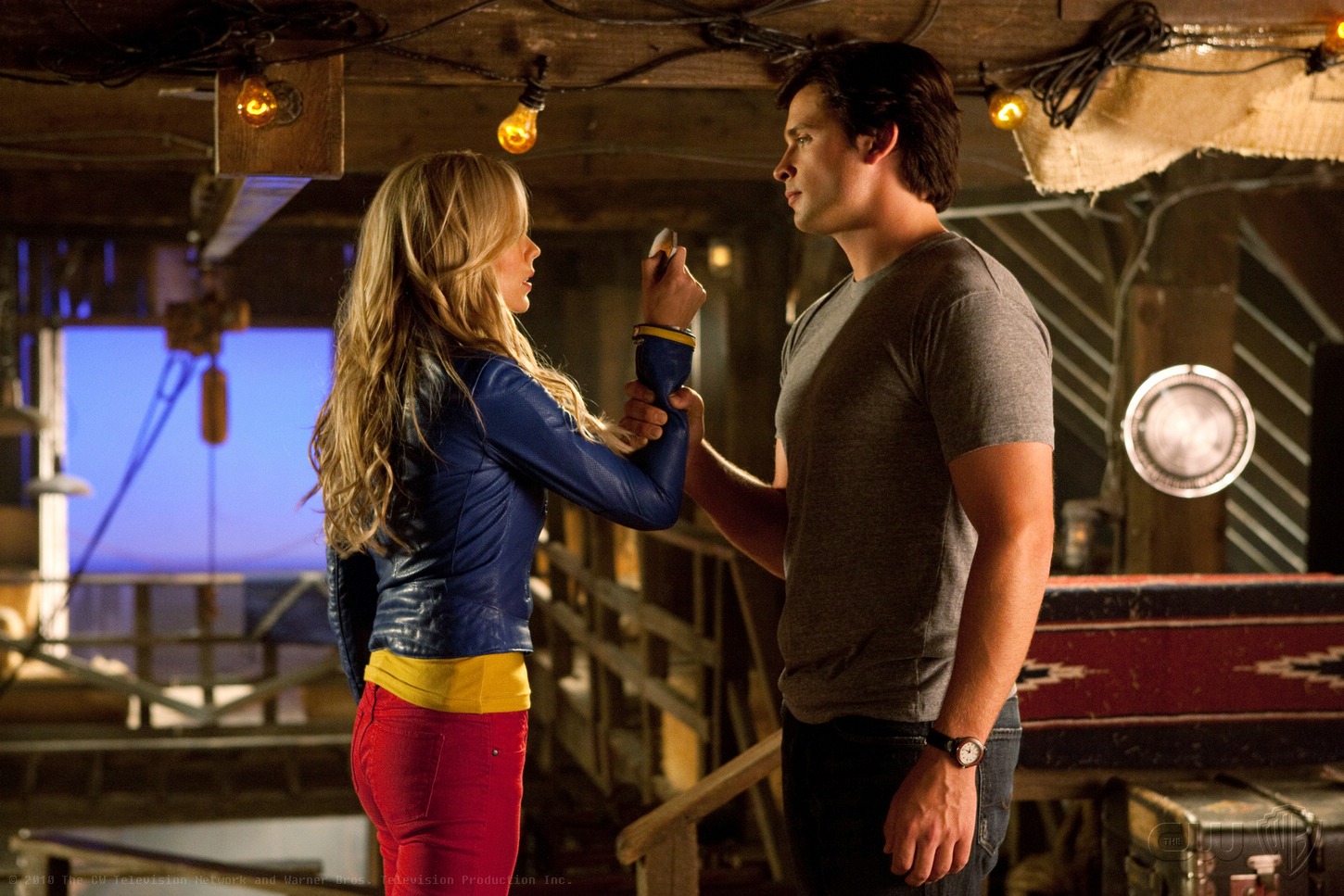
As I said this article is just an overview of the origins and first motion picture and television appearances of three Detective Comics superheroes that are in reality only two Superman and his cousin Supergirl. It also shows the variance, over time, of how they were presented on both the big and small screens.
There is now a wonderful reboot of "Supergirl" on television. That is both today, but also reminds this old man of the George Reeves television series with just the right mix of nostalgia.
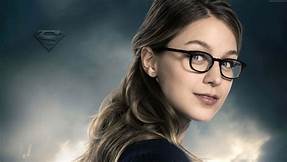

REMEMBER!
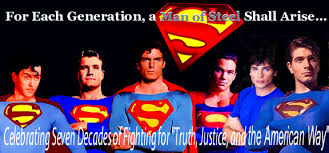
Not a very engaging story line and compared to the first two of the Christopher Reeve films boring.
On May 2, 1998 the first television appearance of "Supergirl" took place in "Superman: The Animated Series". The episode was called "Little Girl Lost". In this story there are also changes to the original origin of Kara. In deep space Superman discovers the planet Argo. The planet was affected by the destruction of Krypton and became a frigid world. For protection of her family a scientist named Kala In-Ze placed them in suspended animation. All the chambers have been destroyed except one containing a teenage girl Kara In-Ze.
The story cuts to three years later the girl now on Earth has become "Supergirl" and is told she must watch out nobody discovers her superpowers and stay out of trouble.
This was a two part cartoon and during the second part Supergirl helps Superman defeat Darkseid and the Furies.
From this point forward Supergirl started to guest appear on different DC animated series. She teamed up with Batgirl in one series and became a member of the new Justice League in another.
A completely different take on Kara and Supergirl was her first live appearance as part of the television show "Smallville". Which itself was a completely updated feel to the life of the young Clark Kent/Superboy. During the final episode of Season Six on May 17, 2007. Kara is freed after 18 years from suspended animation. Kara/Supergirl was played by Laura Vandervoot.


As I said this article is just an overview of the origins and first motion picture and television appearances of three Detective Comics superheroes that are in reality only two Superman and his cousin Supergirl. It also shows the variance, over time, of how they were presented on both the big and small screens.
There is now a wonderful reboot of "Supergirl" on television. That is both today, but also reminds this old man of the George Reeves television series with just the right mix of nostalgia.

REMEMBER!







No comments:
Post a Comment